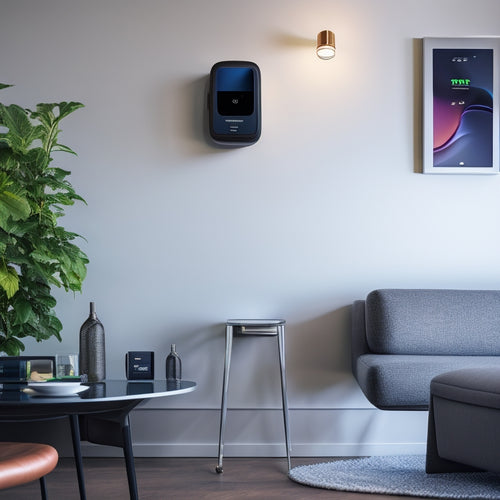
Challenges in Retaining Electric Vehicle Consumers Revealed
Share
A significant hurdle in the widespread adoption of electric vehicles is the high discontinuance rate among early adopters, with 21% of plug-in hybrid owners and 19% of battery electric vehicle owners abandoning the technology. Dissatisfaction with charging convenience, ownership of less efficient vehicles, and lack of Level 2 home charging are key factors driving discontinuance. Understanding these patterns is important for promoting continued adoption, as retaining consumers is essential for market growth. By addressing convenience and efficiency concerns, manufacturers can enhance consumer satisfaction and foster a loyal customer base, ultimately paving the way for a more sustainable transportation future.
Key Takeaways
• Dissatisfaction with charging convenience is a key factor driving electric vehicle discontinuance, highlighting the need for improved infrastructure.
• Ownership of household vehicles with lower efficiencies correlates with higher discontinuance rates, emphasizing the importance of efficient vehicle options.
• Later adoption of plug-in electric vehicles increases the likelihood of discontinuance, suggesting targeted marketing efforts for early adopters.
• The absence of Level 2 (220V) charging at home significantly contributes to discontinuance, underscoring the need for accessible charging infrastructure.
• Non-male ownership is a demographic factor correlated with discontinuance, indicating a need for targeted marketing and support for underrepresented groups.
Factors Driving Discontinuance
Among electric vehicle (EV) adopters, several factors contribute to discontinuance, including dissatisfaction with the convenience of charging, owning household vehicles with lower efficiencies, and being a later adopter of plug-in electric vehicles (PEVs).
These discontinuance drivers have a considerable impact on consumer satisfaction, leading to a decrease in EV adoption. Importantly, the absence of Level 2 (220V) charging at home and being a non-male owner also contribute to discontinuance.
Understanding these factors is vital in addressing the barriers to widespread EV adoption. By identifying and mitigating these discontinuance drivers, manufacturers and policymakers can enhance consumer satisfaction, promoting a smooth shift to electric vehicles.
Impact on Electric Vehicle Market
Discontinuance among electric vehicle adopters has significant implications for market growth, with a notable 21% discontinuance rate among plug-in hybrid adopters and 19% among battery electric vehicle adopters, hindering the progress towards widespread electric vehicle adoption.
This discontinuance hampers market growth, as it prevents the industry from reaching its full potential. The high discontinuance rates indicate a lack of consumer satisfaction, which is vital for sustaining market growth.
To address this, manufacturers and policymakers must focus on enhancing convenience and efficiency in charging, as well as promoting early adoption and continued support for electric vehicles. By doing so, they can improve consumer satisfaction, thereby driving market growth and facilitating the shift to a more sustainable transportation sector.
Key Findings on PEV Ownership
Research on plug-in electric vehicle (PEV) ownership reveals a significant correlation between discontinuance and various factors, including refueling style, convenience, and efficiency. Importantly, dissatisfaction with convenience of charging and owning household vehicles with lower efficiencies are key contributors to discontinuance.
Moreover, being a later adopter of PEVs and not having Level 2 (220V) charging from home also increase the likelihood of discontinuing PEV ownership. Understanding these factors is vital in enhancing PEV ownership satisfaction and addressing consumer preferences.
Understanding Discontinuance Patterns
Patterns of discontinuance among electric vehicle owners reveal distinct correlations between demographic and behavioral factors, highlighting the importance of understanding these relationships to inform strategies that promote continued adoption.
Research has identified key factors contributing to discontinuance, including:
- Dissatisfaction with convenience of charging and owning household vehicles with lower efficiencies.
- Not having Level 2 (220V) charging from home and being a later adopter of PEVs.
- Not being male, which is a demographic factor correlated with discontinuance.
Understanding these discontinuance trends is vital in addressing consumer behavior and promoting continued adoption of electric vehicles.
Overcoming Barriers to Adoption
To overcome the barriers to electric vehicle adoption, it is essential to address the convenience and efficiency concerns that lead to discontinuance, particularly with regards to charging infrastructure and vehicle performance.
Implementing effective adoption strategies can enhance consumer satisfaction, a vital factor in promoting continued ownership. By addressing the barriers to adoption, electric vehicle manufacturers can increase consumer retention rates, ultimately contributing to successful market growth.
Development of convenient and efficient charging infrastructure, as well as improved vehicle performance, are critical components of a thorough adoption strategy. By prioritizing consumer satisfaction, electric vehicle manufacturers can foster a loyal customer base, driving long-term market growth and adoption.
Frequently Asked Questions
What Is the Average Time Before Electric Vehicle Owners Discontinue Use?
The average time before electric vehicle owners discontinue use is unclear, but usage patterns and battery degradation may influence this decision, with owners potentially discontinuing use after 3-5 years due to reduced battery efficiency and decreased range.
Do Government Incentives Impact Electric Vehicle Discontinuance Rates?
Government incentives can moderately mitigate electric vehicle discontinuance rates, as policy-driven benefits can enhance ownership experiences, but their effectiveness is contingent upon addressing underlying barriers, such as charging convenience, to guarantee sustained adoption.
Can Public Charging Infrastructure Reduce Discontinuance?
Public charging infrastructure can mitigate discontinuance by ensuring reliable charging experiences, particularly in urban planning contexts where charging reliability and accessibility are critical, thereby enhancing overall convenience and efficiency for electric vehicle owners.
How Does Range Anxiety Affect Electric Vehicle Ownership Satisfaction?
Range anxiety greatly impacts electric vehicle ownership satisfaction, inducing mental stress and altering daily habits, as owners adapt their behavior to mitigate anxiety, highlighting the need for reliable charging infrastructure to alleviate concerns.
Do Electric Vehicle Manufacturers Provide Sufficient Post-Purchase Support?
Electric vehicle manufacturers' post-purchase support is paramount; a robust dealer network that meets customer expectations is essential for ensuring seamless ownership experiences, fostering loyalty, and mitigating discontinuance.
Related Posts
-

7 Best EV Battery Health Trackers for Homeowners
You can maximize your electric vehicle's performance and lifespan by leveraging advanced battery health trackers that...
-

10 Eco-Friendly Air Management Tools for Clean Home Living
You're taking an essential step towards creating a healthier living space by seeking eco-friendly air management tool...
-

10 Best Sustainable Waste Management Solutions for Green Homes
You're likely unaware that the average green home generates over 2 kilograms of waste daily, but with the right susta...


